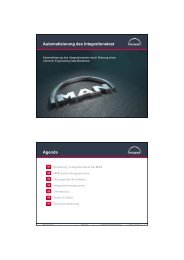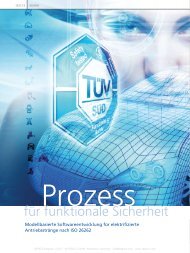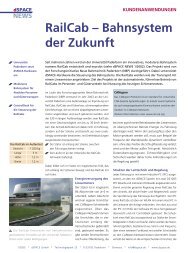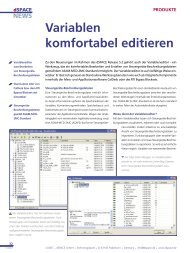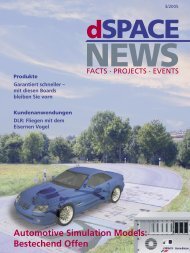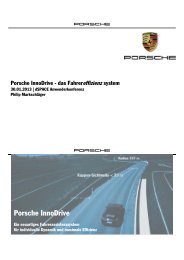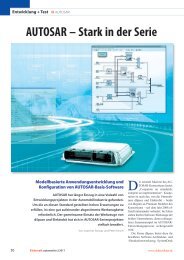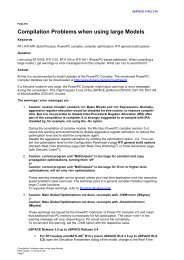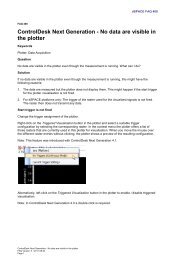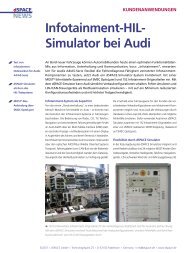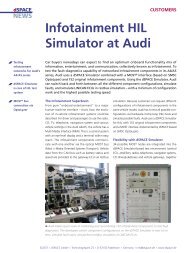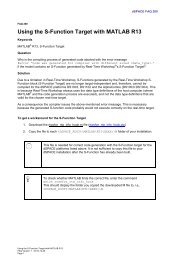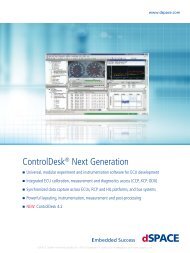magazinE - dSPACE
magazinE - dSPACE
magazinE - dSPACE
You also want an ePaper? Increase the reach of your titles
YUMPU automatically turns print PDFs into web optimized ePapers that Google loves.
Two of our students in the faculty of<br />
engineering required an induction<br />
motor test bench for developing control<br />
functions as part of their work on<br />
their degree theses. They quickly set<br />
up the first version of the test bench,<br />
which other students developed<br />
further in subsequent semesters. The<br />
work of Marcelo Bruno, one of these<br />
students, was selected to start the<br />
joint graduation program agreed<br />
between the University of Buenos<br />
Aires and the University of Rome<br />
“La Sapienza”. The test bench is now<br />
fitted with modern control technology<br />
equipment and has become an<br />
indispensable teaching aid. Moreover,<br />
it is an important link between the<br />
university and industry, and has<br />
proved invaluable in industryrelated<br />
development projects and commissioned<br />
work. A joint project between<br />
the Argentine company Motortech<br />
S.A. and the faculty of engineering at<br />
the University of Buenos Aires is<br />
currently underway.<br />
Uses of the Test Bench<br />
The test bench for 3phase induction<br />
motors has a wide range of uses:<br />
For projectrelated research, in work<br />
on degree & doctoral theses and in<br />
cooperation with industry. Our main<br />
aim in using the test bench is to<br />
ensure fast transfer from theory to<br />
practice, i.e., when students have<br />
learned something, they can put it<br />
into practice at once. The students<br />
The torque gauge helps the students check<br />
the efficiency of the algorithms developed.<br />
Prof. Hernán Tacca’s students use the test<br />
bench extensively for their studies and<br />
for orders from industry. From left to right:<br />
Prof. Hernán Tacca, Pablo Witis,<br />
Yaki Nachajón and Gustavo Bongiovanni.<br />
develop new control functions and<br />
can modify them continuously. They<br />
see the results of their work immediately<br />
without having to make timeconsuming<br />
or expensive hardware<br />
modifications. This way, students<br />
acquire comprehensive knowledge<br />
and can familiarize themselves with<br />
the latest technology and developments<br />
in the field of embedded<br />
systems. The AADECA (Argentine<br />
Association of Automatic Control)<br />
awarded this work the first prize in<br />
the development contest for<br />
graduation projects carried out by<br />
undergraduate students in 2006.<br />
a Worthwhile investment<br />
From the beginning, we opted to use<br />
components from <strong>dSPACE</strong>. We<br />
began with the DS1102 Controller<br />
Board. After positive experience with<br />
“ We chose <strong>dSPACE</strong> because we want<br />
to prepare our students optimally for the<br />
standards used in industry.”<br />
this, we continued with its successor,<br />
the DS1103 PPC Controller Board.<br />
RealTime Interface lets us program<br />
the DS1103 straight from the block<br />
diagram environment in Simulink.<br />
This means that new control functions<br />
can be quickly implemented<br />
and evaluated on the board. We use<br />
Acknowledgements<br />
The success of this work has been possible thanks to<br />
the research grants obtained for projects I022 and<br />
I003 from the UBACYT Scientific Program of Buenos<br />
Aires University and the YPF Foundation donations.<br />
the ControlDesk experiment software<br />
to create humanmachine interfaces<br />
and control realtime simulations.<br />
Why We Chose dSPaCE<br />
Advised by Prof. Carlos Godfrid,<br />
Professor of Control Engineering at<br />
Prof. Hernán E. Tacca, University of Buenos Aires<br />
the University of Buenos Aires with<br />
many years of experience in using<br />
<strong>dSPACE</strong> tools, we chose these tools<br />
because we want to prepare our<br />
students optimally for the standards<br />
used in industry. The userfriendly<br />
handling of <strong>dSPACE</strong> tools was<br />
another factor, since we can easily<br />
connect any hardware to the test<br />
bench in plug & play mode to develop<br />
and test new control functions.<br />
The postsales support we are<br />
given is also firstclass. Funding from<br />
industry helps us purchase these<br />
reliable, highperformance tools.<br />
Yaki Nachajón, Pablo Witis, Pablo Rossi,<br />
and Marcelo Bruno (Students)<br />
Prof. Hernán E. Tacca and<br />
Prof. Carlos Godfrid (Advisors)<br />
Faculty of Engineering<br />
University of Buenos Aires, Argentina<br />
pAGe 35



